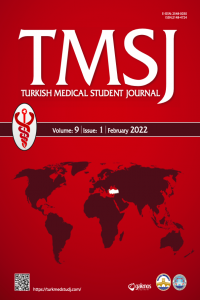THE INFLUENCE OF METABOLIC THERAPY ON CLINICAL AND HEMODYNAMIC PARAMETERS IN PATIENTS WITH STABLE ANGINA
THE INFLUENCE OF METABOLIC THERAPY ON CLINICAL AND HEMODYNAMIC PARAMETERS IN PATIENTS WITH STABLE ANGINA
Hemodynamics, stable angina, carnitine,
___
- 1. World Health Organization. Cardiovascular diseases (CVDs). Available from URL:http://www.who.int/news-room/fact-sheets/detail/cardiovascular-diseases-(cvds) (17/05/2017).
- 2. Centre for disease control. National Center for Health Statistics. National Health Interview Survey, 2016. (cited 2018 Sep 21). Available from URL: https://www.cdc.gov/nchs/nhis/shs/tables.htm.
- 3. Dzerve V, Matisone D, Pozdnyakov Y et al. Mildronate improves the exercise tolerance in patients with stable angina: results of a long term clinical trial. Seminars in Cardiovascular Medicine 2010;16:3.
- 4. Liepinsh E, Makarova E, Sevostjanovs E et al. Carnitine and γ‐butyrobetaine stimulate elimination of meldonium due to competition for octn2‐mediated transport. Basic Clin Pharmacol Toxicol 2017;120(5):450-6.
- 5. Lindquist C, Bjørndal B, Rossmann CR et al. A fatty acid analogue targeting mitochondria exerts a plasma triacylglycerol lowering effect in rats with impaired carnitine biosynthesis. PLoS ONE 2018;13(3):1-16.
- 6. Dzerve V, MILSS I Study Group. A dose-dependent improvement in exercise tolerance in patients with stable angina treated with mildronate: a clinical trial “MILSS I”. Medicina (Kaunas) 2011;47(10):544-51.
- 7. Zhernakova NI, Olesya V, Romaschenko et al. The importance of the smoking factor in personalized complex pharmaco- therapy of ischemic heart disease with the use of metabolic correctors. International Journal of Advanced Biotechnology and Research 2018;9(1):1016-21.
- 8. Canadian Cardiovascular Society. “Canadian Cardiovascular Society grading of angina pectoris”. (cited 2018 Sep 25). Available from URL: http://www.ccs.ca/images/Guidelines/Guidelines_POS_Library/Ang_Gui_1976.pdf.
- 9. Electrocardiographic complex CARDIOLABS. (cited 2018 Sep 25). Available from URL: http://xai-medica.com/cardiolab+/.
- 10.Veloergometer SECA CARDIOTEST. (cited 2018 Sep 24). Available from URL: http://www.esus.ru/php/content.php?id=3134.
- 11. Danilenko LM, Klochkova GN, Kizilova IV et al. Metabolic cardioprotection: new concepts in implementation of cardioprotective effects of meldonium. Research result 2016;2(3):95-100.
- 12. Zhu Y, Zhang G, Zhao J et al. Efficacy and safety of mildronate for acute ischemic stroke: a randomized, double-blind, active-controlled phase II multicenter trial. Clin Drug Investig 2013;33:755.
- 13. Sakharchuk II, Denisenko GT, Grushko VS et al. The use of mildronat in heart failure in patients with chronic ischemic heart disease. Vrach Delo 1989;9:21-3.
- 14.Dudko VA, Koshel’skaia OA, Sokolov AA. The use of mildronat with stenocardia patients. Vrach Delo 1989;10:64-7.
- 15.Ol’binskaia LI, Golokolenova GM. Use of mildronate in cardiac insufficiency in patients with ischemic heart disease. Klin Med (Mosk) 1990;68:39-42.
- 16.Karpov RS, Dudko VA, Shipulin VM et al. The clinical instrumental evaluation of treatment efficacy in patients with concomitant atherosclerosis of the coronary, cerebral and peripheral arteries. Ter Arkh 1991;63:90-3.
- 17.Teplyakov AT, Sankevitch TV, Stepatcheva TA et al. The use of fatty acid beta- oxidation inhibitor mildronate as monotherapy or incombination with atenolol in patients with left ventricular dysfunction after myocardial infarction. Kardiologiia 2003;43:15-8.
- 18.Enina G, Timofeeva T, Egere D et al. Medicinal effects and indications to mildronate application in neuro angiologic practice. Experimental and Clinical Pharmacotherapy 1991;19:164-71.
- ISSN: 2148-4724
- Başlangıç: 2014
- Yayıncı: Trakya Üniversitesi
Varahabhatla Vamsi, Maganty Virajitha, Lihasenko Ivetta
RESEARCH OF URGENT BIOCHEMISTRY TEST ORDERING HABIT
Kubilay ELMACI, Betül İNCE, Sevgi ESKİOCAK, Eray ÖZGÜN
Berkay KEF, Nur Gülce İŞKAN, Kemal KEF
THE EVALUATION OF MUSCULOSKELETAL SYSTEM TUMORS AND TUMOR LIKE LESIONS IN THRACE REGION
Ece ŞENYİĞİT, Begüm SÖYLEYİCİ, Nur Gülce İŞKAN, Hilal Sena ÇİFCİBAŞI, Aslı GÖZTEPE, Mert ÇİFTDEMİR
THE INVESTIGATION OF UNIVERSITY STUDENTS’ KNOWLEDGE ON NUTRITION AND EATING HABITS
Ertuğrul KOÇAK, Atakan Muhammet PARLAK, Orkun Salih KIZILKAYA, Burak BARDAKÇI, Musa Eralp KILIÇ, Sevgi ESKİOCAK
THE EFFECT OF PREVENTION FOR PEER BULLYING IN SECONDARY SCHOOL
Batuhan Mutlu, Şermin Yalın Sapmaz, Beyhan Cengiz ÖZYURT, İrem ŞENEL, Elif METİN, Melisa SARGUT, Riyadh SAEED, Bengisu UZEL TANRIVERDİ, Hasan KANDEMİR, Cevval ULMAN
